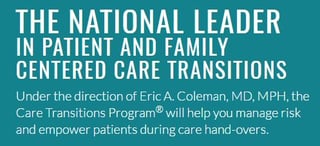 There is a growing body of evidence that non-medical caregivers can play a key role in helping their clients avoid preventable hospitalizations. A pioneer in this regard is Dr. Eric Coleman whose website is www.caretransitions.org. Dr. Coleman has an evidence-based methodology for managing care transitions from hospital to home and reducing preventable readmissions.
There is a growing body of evidence that non-medical caregivers can play a key role in helping their clients avoid preventable hospitalizations. A pioneer in this regard is Dr. Eric Coleman whose website is www.caretransitions.org. Dr. Coleman has an evidence-based methodology for managing care transitions from hospital to home and reducing preventable readmissions.
We've written about the "Coleman Model" in the past and you can read more detail here, but for a brief recap, Dr. Coleman's methodology involves visits with the patient before they are discharged, a visit shortly after their arrival at home, and follow up visits or phone calls. The content of these interventions is based on four pillars of focus as follows:
-
Med Management
-
Creating a Personal Health Record
-
Following up with Primary Care
-
Understanding the Red Flags
You may be tempted to stop reading because you don't do med management but you can partner with the hospital on this one. The discharge nurse can document the med requirements and your non-medical team can make sure that the prescriptions are filled and that the client is following the hospital's instructions.
Dr. Coleman Advocates for Caregivers in the Journal of Hospital Medicine
Seeing articles published in medical journals about the importance of caregivers tells us clearly that home care's role in healthcare is growing. You can read Dr. Coleman's full article here, but here's a synopsis:
-
The Caregiver Advise Record Enable (CARE) Act has been promoted by AARP and passed into law in 30 states. An additional 12 states are evaluating it.
-
The law requires the following:
-
The caregiver* be recorded on the medical record
-
The caregiver be informed of discharge
-
The caregiver needs to be informed of the medical tasks that they need to fulfill
-
*Important note - a lot of this is focused on the "family caregiver" as opposed to the caregiver provided by your agency, but in some cases including Consumer Directed Services (CDS) they are one and the same. Even if not, your caregiver is likely to be working under the direction of the family caregiver.
The purpose of Dr. Coleman's paper is to inform and encourage hospitals to understand this act and to work with you and the families you care for to make it happen. This does, admittedly, show that there remains a need to educate the healthcare world on the importance that home care can bring.
Please note that the Care Transitions Intervention and the Care Transitions Program are registered trademarks copyrighted by Dr. Eric Coleman. For more information to to be trained on this methodology, go to www.caretransitions.org.
A couple of offers:
-
If you are a Care Transitions Program partner and need software, please contact us.
-
You may enjoy our latest e-book, "Blueprint for the Next Generation of Healthcare at Home" Just click the link to download the paper.
Ankota provides software to improve the delivery of care outside the hospital, focusing on efficiency and care coordination. Ankota's primary focus is on Care Transitions for Readmission avoidance and on management of Private Duty non-medical home care. To learn more, please visit www.ankota.com or contact us.




Your Comments :